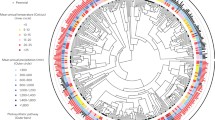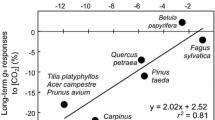Summary
The relationships of photosynthetic characteristics to the competitive interactions of a C3 plant, Chenopodium album, and a C4 plant, Amaranthis retroflexus, were investigated in different temperature and water supply regimes. Both species had similar photosynthetic rates at 25°C, but at higher temperatures, Amaranthus had substantially greater rates than Chenopodium. Conversely, at lower temperatures, Chenopodium had an advantage. The competitive abilities in mixtures exhibited a close parallel to the photosynthetic performances with Amaranthus having an advantage at high temperatures and Chenopodium an advantage at low temperatures. These competitive outcomes were determined primarily by differences in relative growth rates prior to canopy closure. In the respective, temperature regimes, the species having the highest photosynthetic rate, which resulted an more rapid growth, overtopped and shaded the other species at the time of canopy closure. These results demonstrate that differences in photosynthetic temperature response between C4 and C3 plants can be an important determinant in competitive interactions, but at least in this case, the influence is primarily through, events prior to the actual initiation of competition.
In contrast to temperature, growth of the plants under limited water supply had no influence on the competitive interactions. Thus, the presence of the C4 pathway alone was not sufficient to yield a competitive advantage over the C3 species under water limited conditions.
Similar content being viewed by others
References
Baskin JM, Baskin CC (1978) A discussion, of the growth and competitive ability of C3 and C4 plants. Castanea 43:71–76
Bjorkman O (1973) Comparative studies on photosynthesis in higher plants. In: Photophysiology AC Giese (ed), Vol 8 Academic Press, New York London, p 1–63
Bjorkman O (1975), Environmental and biological control of photosynthesis: Inaugural address. In: R Marcelle (ed) Environmental and biological control of photosynthesis. Dr W Junk The Hague, p 1–16
Black CC (1971) Ecological implications of dividing plants into groups with distinct photosynthetic production capacities. Adv Ecol Res 7:87–114
Black CC, Chen TM, Brown RH (1969) Biochemical basis for plant competition. Weed Sci 17:338–344
Bull TA (1969) Photosynthetic efficiencies and photorespiration in Calvin cycle and C4 dicarboxylic acid plants. Crop Sci 9:726–729
Clements FE, Weaver JE, Hanson HC (1929) Plant competition. Carnegie Inst Wash Washington
Cohen D (1970) The expected efficiency of water utilization in plants under different competition, and selection regimes. Israel J Bot 19:50–54
Downes RW (1969) Differences in transpiration rates between tropical and temperate grasses under controlled conditions. Planta 88:261–273
Ehleringer JR (1978) Implications of quantum yield differences on the distributions of C3 and C4 grasses. Oecologia (Berl) 31:255–267
Ehleringer JR, Bjorkman O (1977) Quantum yields for CO2 uptake in C3 and C4 plants. Dependence on temperature, CO2 and O2 concentration. Plant Physiol 59:86–90
Harper JL (1977) Population biology of plants. Academic Press. New York London
Hofstra JJ, Stienstra AW (1977) Growth and photosynthesis of closely related C4 grasses as influenced by light intensity and water supply. Acta Bot Neerl 26:63–72
Jarvis P (1971) The estimation of resistances to carbon dioxide transfer. In: Plant photosynthetic production: Manual of methods. Z Sestak, J Catsky, PG Jarvis (eds) Junk The Hague p 566–631
Ludlow MM (1976) Ecophysiology of C4 grasses In: OL Lange, L Kappen, ED Schulze (eds) Water and plant life. Springer Berlin Heidelberg New York, p 364–386
Osmond CB, Troughton JH, Goodchild DJ (1969) Physiological, biochemical, and structural studies of photosynthesis and photorespiration in two species of Atriplex. Z. Pflanzenphysiol 61:218–237
Patterson DT (1976) C4 photosynthesis in smooth pigweed. Weed Sci 24:127–130
Pearcy RW (1976) Temperature responses of growth and photosynthetic CO2 exchange rates in coastal and desert races of Atriplex, lentiformis. Oecologia (Berl) 26:245–255
Ross MA, Harper JL (1972) Occupation of biological space during seedling establishment J Ecol 60:77–88
Slatyer RO (1970) Comparative photosynthesis, growth and transpiration of two species of Atriplex. Planta 93:175–189
Teeri JA (1979) The climatology of the C4 photosynthetic pathway. In: Topics in plant population biology. OT Solbrig, S Jain, GB Johnson, PH Raven (eds) Columbia Univ Press New York, p 356–374
Teeri JA, Stowe LG (1976) Climatic patterns and the distribution of C4 grasses in North America. Oecologia (Berl) 23:1–12
de Wit CT (1960) On competition Versl Landbouwk Onderz 66:1–82
Author information
Authors and Affiliations
Rights and permissions
About this article
Cite this article
Pearcy, R.W., Tumosa, N. & Williams, K. Relationships between growth, photosynthesis and competitive interactions for a C3 and C4 plant. Oecologia 48, 371–376 (1981). https://doi.org/10.1007/BF00346497
Received:
Issue Date:
DOI: https://doi.org/10.1007/BF00346497




